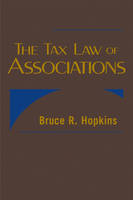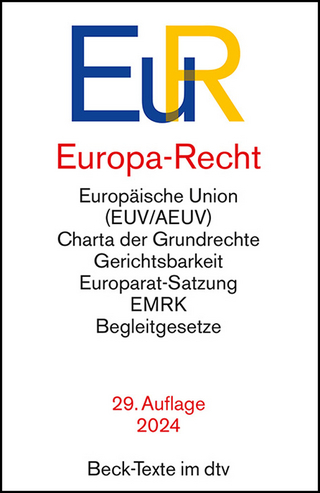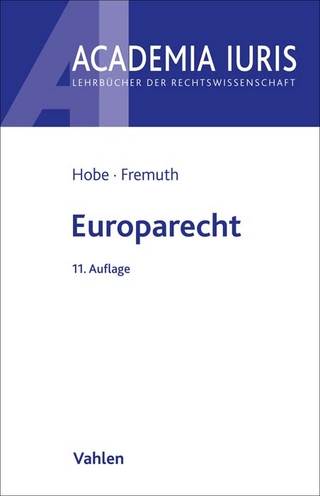
The Tax Law of Associations
John Wiley & Sons Inc (Verlag)
978-0-471-77153-1 (ISBN)
- Titel ist leider vergriffen;
keine Neuauflage - Artikel merken
Bruce R. Hopkins is the country's leading authority on the law of tax-exempt organizations and is a lawyer with the firm Polsinelli Shalton Welte Suelthaus PC. He is also the author of 19 books, including The Law of Tax-Exempt Organizations, Eighth Edition; Planning Guide for the Law of Tax-Exempt Organizations; The Tax Law of Unrelated Business for Nonprofit Organizations; Nonprofit Law Made Easy; 650 Essential Nonprofit Law Questions Answered; The Law of Fundraising, Third Edition; Private Foundations: Tax Law and Compliance, Second Edition; The Tax Law of Charitable Giving, Third Edition; The Law of Intermediate Sanctions; and The Law of Tax-Exempt Healthcare Organizations, Second Edition; all published by John Wiley & Sons. Mr. Hopkins also writes the monthly newsletter Bruce R. Hopkins' Nonprofit Counsel, also published by John Wiley & Sons.
Preface. Chapter One: Associations, Society, and the Tax Law. 1.1 Introduction to Associations. 1.2 History and Evolution of Associations. 1.3 Role of Associations in Society. (a) Professional Development and Continuous Skill-Building. (b) Information. (c) Standards-Setting, Codes of Ethics, and Certification. (d) Research and Statistics. (e) Volunteerism and Community Service. (f) Constituent Contact. (g) Giving Voice to Citizens. (h) Economic Impact. (i) Social and Networking Functions. 1.4 Rationales for Associations' Tax Exemption. 1.5 Forms of Associations. 1.6 Other Exempt "Associations": A Comparative Analysis. (a) Social Welfare Organizations. (b) Local Associations of Employees. (c) Labor Organizations. (d) Agricultural Organizations. (e) Horticultural Organizations. (f) Social Clubs. (g) Fraternal Beneficiary Societies. (h) Voluntary Employees' Beneficiary Associations. (i) Domestic Fraternal Societies. (j) Teachers' Retirement Fund Associations. (k) Benevolent Life Insurance Associations. (l) Cemetery Companies. (m) Veterans' Organizations. (n) State-Sponsored Medical Care Organizations. (o) State-Sponsored Workers' Compensation Entities. (p) Religious or Apostolic Organizations. (q) Farmers' Cooperatives. (r) Shipowners' Protection and Indemnity Associations. (s) Homeowners' Associations. (t) Quasi-Governmental Entities. (u) Other Membership Organizations. 1.7 Comparisons to Other Exempt Organizations. Chapter Two: Tax Exemption for Business Leagues and Similar Organizations. 2.1 Concept of Tax Exemption. 2.2 Recognition of Tax Exemption. 2.3 Appropriate Exemption Category. 2.4 Business Leagues in General. (a) General Principles. (i) Tax Law Characteristics. (ii) Members. (iii) Dues. (b) Varieties of Exempt Business Leagues. (c) Certification Programs. 2.5 Legislative and Regulatory History. (a) Legislative History. (b) Regulatory History. 2.6 Definition of Business. 2.7 Line-of-Business Requirement. (a) Concept of Line of Business. (b) Supreme Court Pronouncement. (c) Other Developments in Law. 2.8 Membership Services. 2.9 Professional Organizations. 2.10 Disqualifying Activities. (a) Line-of-Business Requirement. (b) For-Profit Business Activities. (i) General Rule. (ii) Incidental Business Activity. (c) Performance of Particular Services. (i) Particular Services. (ii) General Rule. (iii) Particular Services Outside Membership. (iv) Unrelated Business Activities. (d) Private Inurement. 2.11 Chambers of Commerce. 2.12 Boards of Trade. 2.13 Real Estate Boards. 2.14 Professional Football Leagues. 2.15 Application for Recognition of Exemption (Form 1024). 2.16 Nonexempt Membership Organizations. Chapter Three: Private Inurement, Private Benefit, and Excess Benefit Transactions. 3.1 Essence of Private Inurement. 3.2 Concept of Net Earnings. 3.3 Requisite Insider. 3.4 Types of Private Inurement. (a) Compensation for Services. (i) Meaning of Compensation. (ii) Determining the Reasonableness of Compensation. (iii) Percentage-Based Compensation. (iv) Multiple Payors. (v) Role of the Board. (vi) Tax-Exempt Organizations Checklist. (vii) Board Member Compensation. (viii) Actuality of Services Rendered. (b) Other Forms of Private Inurement. (i) Rental Arrangements. (ii) Lending Arrangements. (iii) Sales of Assets. (iv) Equity Distributions. (v) Assumptions of Liability. (vi) Employee Benefits. (vii) Tax Avoidance Schemes. (viii) Services Rendered. (ix) Provision of Goods or Refreshments. (x) Retained Interests. (xi) Embezzlements. 3.5 Private Inurement and Associations. 3.6 Private Benefit Doctrine. (a) General Rules. (b) Import of Joint Venture Law. (c) Perspective. 3.7 Private Benefit and Associations. (a) Summary of Facts. (b) Summary of Opinion. (c) Commentary. 3.8 Excess Benefit Transactions. (a) Introduction to Intermediate Sanctions. (b) Tax-Exempt Organizations Involved. (c) Disqualified Persons. (d) Transactions Involved. (i) General Rules. (ii) Automatic Excess Benefit Transactions. (iii) Initial Contract Exception. (e) Rebuttable Presumption of Reasonableness. (f) Tax Structure. (g) Reimbursements and Insurance. (h) Return for Payment of Excise Taxes. (i) Statute of Limitations. (j) Scope of the Sanctions. 3.9 Associations and Intermediate Sanctions. Chapter Four: Lobbying and Political Activities. 4.1 Associations and Lobbying. 4.2 Lobbying Tax Law Rules. (a) General Business Expense Deduction Disallowance Rules. (i) General Rules. (ii) Examples of Influencing Legislation. (iii) Lobbying and Nonlobbying Activities. (iv) Research Expenditures. (v) In-House Expenditures. (vi) Cost Allocation Rules. (vii) Lobbying for Others. (viii) Anti-Cascading Rule. (ix) Anti-Avoidance Rule. (b) Association Flow-Through and Proxy Tax Rules. (i) Disclosure and Notice Requirements. (ii) Proxy Tax. 4.3 Associations and Political Campaign Activities. 4.4 Public Advocacy Activities. 4.5 Political Activities Tax Law Rules. (a) General Business Expense Deduction Disallowance Rules. (b) Association Flow-Through and Proxy Tax Rules. 4.6 Constitutionality of Statutory Scheme. 4.7 Associations' Use of Political Organizations. (a) Political Organizations in General. (b) Associations and Political Organizations. Chapter Five: Unrelated Business Rules. 5.1 Analytic Framework. 5.2 Definition of Trade or Business. (a) General Rules. (b) Commerciality. (c) Charging of Fees. (d) Nonbusiness Activities. (e) Real Estate Activities. (f) Efficiencies of Operation. (g) Occasional Sales. 5.3 Fragmentation Rule. 5.4 Profit Motive Requirement. 5.5 Regularly Carried On Rule. (a) General Rules. (b) Determining Regularity. (c) Fundraising and Similar Activities. (d) Preparatory Time. 5.6 Related Business Rule. 5.7 Substantially Related Business Rule. (a) General Rules. (b) Size and Extent Test. (c) Same State Rule. (d) Dual Use Rule. (e) Exploitation Rule. 5.8 Advertising Activities. 5.9 Exceptions to Rules. (a) Passive Income in General. (b) Dividends. (c) Interest. (d) Securities Lending Transactions. (e) Annuities. (f) Royalties. (g) Rent. (i) General Rules. (ii) Profits-Based Income. (iii) Rental Activity as Related Business. (h) Capital Gains. (i) General Rules. (ii) Exception. (i) Research Income. (j) Charitable Deductions. (k) Specific Deduction. (l) Net Operating Losses. (m) Businesses Conducted by Volunteers. (n) Trade Shows. (i) General Rules. (ii) Virtual Trade Shows. (o) Gambling Activities. (p) Associate Member Dues. (q) Low-Cost Articles. (r) Mailing Lists. (s) S Corporation Holdings and Sales. 5.10 Unrelated Debt-Financed Income Rules. Chapter Six: For-Profit Subsidiaries and Limited Liability Companies. 6.1 Fundamentals of For-Profit Subsidiaries. (a) Establishing For-Profit Subsidiary. (b) Choice of Form. (c) Control Element. 6.2 Potential of Attribution to Parent. 6.3 Financial Considerations. (a) Capitalization. (b) Compensation. (c) Sharing of Resources. 6.4 Asset Accumulations. 6.5 Subsidiaries in Partnerships. 6.6 Effect of For-Profit Subsidiaries on Public Charity Status. (a) Publicly Supported Organizations. (b) Supporting Organizations. 6.7 Treatment of Revenue from Subsidiary. (a) Income Flows to Parent. (b) Taxable Income from Subsidiary. 6.8 Liquidations. 6.9 Associations and For-Profit Subsidiaries. 6.10 Limited Liability Companies. (a) Entity Classification Fundamentals. (i) General Rules. (ii) Tax-Exempt Organization Rules. (b) Disregarded Entities. (c) Multi-Member Limited Liability Company. (i) General Rules. (ii) Association Case Study. (d) Single-Member Limited Liability Company. Chapter Seven: Associations, Partnerships, and Joint Ventures. 7.1 Partnerships Fundamentals. 7.2 Tax Exemption Issue. (a) Evolution of Law. (b) Current State of Law. (i) General Rules. (ii) Health Care Institutions. 7.3 Joint Ventures Fundamentals. 7.4 Whole-Entity Joint Ventures. (a) Overview of the Law. (b) IRS Guidance. (i) Fact Situation 1. (ii) Fact Situation 2. (iii) Summary of Guidance. (iv) Subsequent Case Law. 7.5 Ancillary Joint Ventures. 7.6 Information Reporting. 7.7 Alternatives to Partnerships. Chapter Eight: Association-Related Foundations. 8.1 Distinctions Between Public and Private Charities. 8.2 Organizations with Inherently Public Activity. (a) Churches. (b) Educational Institutions. (c) Hospitals and Other Medical Organizations. (d) Governmental Units. 8.3 Publicly Supported Organizations-Donative Entities. (a) General Rules. (b) Support Test. (c) Facts-and-Circumstances Test. 8.4 Publicly Supported Organizations-Service Provider Entities. (a) Investment Income Test. (b) Concept of Normally. (c) Unusual Grants. (d) Limitations on Support. 8.5 Comparative Analysis of Categories of Publicly Supported Charities. (a) Definition of Support. (b) Major Gifts and Grants. (c) Types of Support. 8.6 Supporting Organizations. (a) Organizational Test. (b) Operational Test. (c) Specified Public Charities. (d) Required Relationships. (e) Operated, Supervised, or Controlled By. (f) Supervised or Controlled in Connection With. (g) Operated in Connection With. (h) Limitation on Control. 8.7 Noncharitable Supported Organizations. 8.8 Association-Related Foundations. (a) Reasons for Association-Related Foundations. (b) Control Factor. (c) Exempt Functions. (d) Fundraising. (e) Planned Giving Program. (f) Public Charity Status. (g) Focus on Supporting Organizations. (h) Conversions. 8.9 Private Benefit Doctrine. Chapter Nine: Charitable Giving and Fundraising. 9.1 Charitable Giving Rules in General. (a) Defining Charitable Gift. (b) Qualified Donees. (c) Gifts of Property. (d) Limitations on Deductibility. (e) Deduction Reduction Rules. (f) Twice-Basis Deductions. (g) Contributions of Vehicles. (h) Contributions of Intellectual Property. (i) Partial Interest Gifts. (j) Gifts of Insurance. 9.2 Planned Giving. (a) Introduction. (b) Charitable Remainder Trusts. (c) Pooled Income Funds. (d) Charitable Lead Trusts. (e) Charitable Gift Annuities. 9.3 Corporate Sponsorship Rules. (a) Background. (b) Qualified Sponsorship Payments. 9.4 Contribution Substantiation Rules. 9.5 Quid Pro Quo Contribution Rules. 9.6 Disclosures by Noncharitable Organizations. 9.7 State Fundraising Regulation. (a) State Regulation in General. (b) Historical Perspective. (c) States' Police Power. (d) Fundamental Definitions. (e) Registration Requirements. (f) Reporting Requirements. (g) Exemptions from Regulation. (h) Fundraising Cost Limitations. (i) Prohibited Acts. (j) Contractual Requirements. (k) Disclosure Requirements. 9.8 Associations and Charitable Giving. Chapter Ten: Annual Reporting and Disclosure Requirements. 10.1 Federal Tax Law Annual Reporting Requirements in General. (a) Contents of Annual Information Return. (i) Form 990. (ii) Form 990, Schedule A. (iii) Form 990, Schedule B. (iv) Form 990-EZ. (v) Due Dates. (vi) Penalties. (vii) Assessments. (viii) Miscellaneous. (b) Exceptions to Reporting Requirements. (i) Churches and Certain Other Religious Organizations. (ii) Small Organizations. (iii) Other Organizations. (c) Limited Liability Companies. (d) Political Organization Reporting Requirements. (i) General Rules. (ii) Filing Dates. (e) Electronic Filing. (i) Mandatory Filing. (ii) Waivers. (iii) Electronic Mail Box. 10.2 Federal Document Availability Requirements. (a) Availability through IRS. (b) Disclosure by Exempt Organizations. (i) General Rules. (ii) Rules as to Inspection. (iii) Rules as to Copies. (iv) Failure to Comply. (v) Widely Available Exception. (vi) Harassment Campaign Exception. (vii) Penalties. (viii) Political Organizations. (ix) Return Preparation. 10.3 Disclosures Regarding Certain Information or Services. 10.4 State Law Requirements. 10.5 Specific Reporting Requirements of Associations. (a) Web Site Address. (b) Revenue. (c) Statement of Functional Expenses. (d) Program Service Accomplishments. (e) Changes in Operations and Documents. (f) Unrelated Business Activity. (g) Related Organizations. (h) Political Expenditures. (i) Public Inspection Requirements. (j) Deductibility of Dues. (k) Income-Producing Activities. (l) Subsidiaries and Disregarded Entities. 10.6 Specific Reporting Requirements of Association-Related Foundations. (a) Recapitulations. (b) Revenue. (c) Fundraising Expenses. (d) Other Information. 10.7 Unrelated Business Income Tax Return. Chapter Eleven: Summary of Non-Tax Association Law. 11.1 Corporate Governance. (a) Terminology. (b) Principal Features of Law. (i) Public Company and Accounting Oversight Board. (ii) Board Funding. (iii) Registration with the Board. (iv) Standards. (v) Inspections. (vi) Investigations. (vii) Nonaudit Services. (viii) Audit Partner Rotation. (ix) Audit Committees. (x) Corporate Responsibility. (xi) Lawyers. (xii) Disgorgement Funds. (xiii) Real-Time Disclosures. (xiv) Other Provisions. (c) Import of Law for Tax-Exempt Organizations. 11.2 Board Member Responsibilities and Duties. (a) Form. (b) Organization's Purposes and Mission. (c) Organization's Activities. (d) Articles of Organization. (e) Structure and Bylaws. (f) Other Documents. (g) Related Entities. (h) Doing Business Rules. (i) Public Charity Status. (j) Perspective. 11.3 Board Member Liability. (a) Incorporation. (b) Indemnification. (c) Insurance. (d) Immunity. (i) Create a Board Book. (ii) Board Address List. (iii) E-mail Communication System. (iv) Minutes. (v) Attend Meetings. (vi) Understand What Is Going On. (vii) Ask Questions. (viii) Board Oversight of Staff. (ix) Conflict-of-Interest Policy. (x) Intermediate Sanctions Compliance. (xi) Read Materials About Nonprofit Boards. (xii) Attend Seminars. (xiii) Retreats. (xiv) Overall Authority. 11.4 Postal Law. (a) Determination of Postal Rates. (b) Qualifying Organizations. 11.5 Federal Election Law. (a) Federal Election Commission. (b) Involvement of Corporations in the Election Process. (c) Separate Segregated Funds. (i) Contributions by a Separate Segregated Fund. (ii) Solicitation of Contributions to an SSF. (iii) Definition of Member. (d) Limitations on Contributions and Expenditures. (e) Soft-Money Restrictions. (f) Solicitations for, Contributions to, Expenditures by Tax-Exempt Organizations. (g) Advocacy and Electioneering. (h) Political Organizations. 11.6 Antitrust Law. (a) Fundamental Principles. (b) Federal Trade Commission Jurisdiction. 11.7 Securities Law. 11.8 Intellectual Property Law. (a) Copyrights. (b) Trademarks. (c) Patents. (d) Trade Secrets. (e) Licensing. (f) Unfair Competition. 11.9 Employee Benefits Law. (a) Compensation Fundamentals. (b) Current Compensation in General. (c) Fringe Benefits. (d) Deferred Compensation. (e) Qualified Plans. (i) Defined Benefit Plans. (ii) Defined Contribution Plans. (iii) Funding Mechanism. (f) 403(b) Plans. (g) Nonqualified Plans. (i) 457(b) Plans. (ii) 457(f) Plans. (iii) Rabbi Trusts. (h) Options for Tax-Exempt Employers. (i) Perspective. 11.10 Internet Law. (a) Internet/E-Commerce. (b) Web Site Use and Management. 11.11 Management of Institutional Funds Act. 11.12 Other Laws. Appendices. Appendix A: Sources of the Law. Appendix B: Form 1024. Appendix C: Form 4720. Appendix D: Form 1023. Appendix E: Form 990. Appendix F: Form 990-T. Tables. Table of Cases. Table of IRS Revenue Rulings and Revenue Procedures Cited in Text. Table of IRS Private Determinations Cited in Text. Table of Cases Discussed in Bruce R. Hopkins' Nonprofit Counsel. Table of IRS Revenue Rulings and Revenue Procedures Discussed in Bruce R. Hopkins' Nonprofit Counsel. Table of IRS Private Determinations Discussed in Bruce R. Hopkins' Nonprofit Counsel. Table of IRS Private Letter Rulings, Technical Advice Memoranda, and General Counsel Memoranda. Index.
| Erscheint lt. Verlag | 25.8.2006 |
|---|---|
| Verlagsort | New York |
| Sprache | englisch |
| Maße | 187 x 257 mm |
| Gewicht | 1086 g |
| Themenwelt | Recht / Steuern ► EU / Internationales Recht |
| Recht / Steuern ► Steuern / Steuerrecht | |
| ISBN-10 | 0-471-77153-8 / 0471771538 |
| ISBN-13 | 978-0-471-77153-1 / 9780471771531 |
| Zustand | Neuware |
| Haben Sie eine Frage zum Produkt? |
aus dem Bereich


